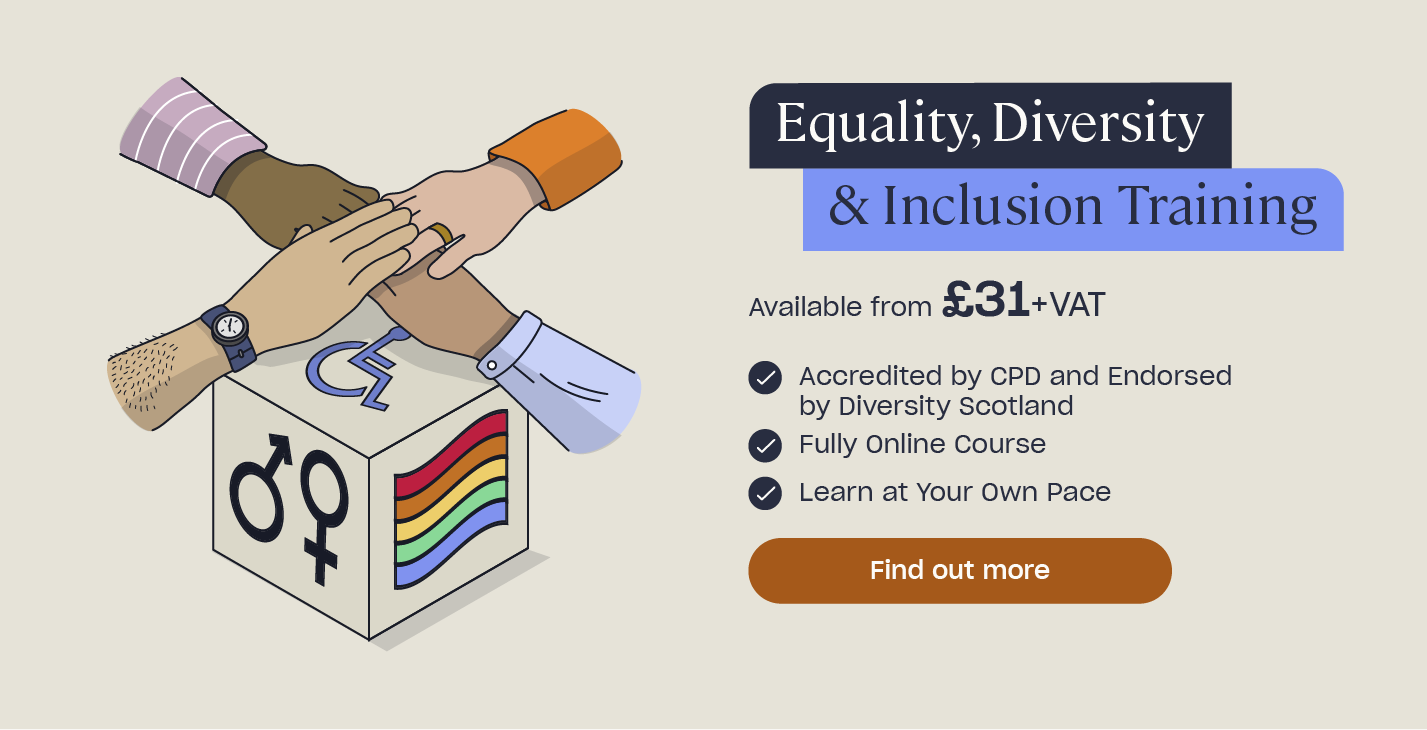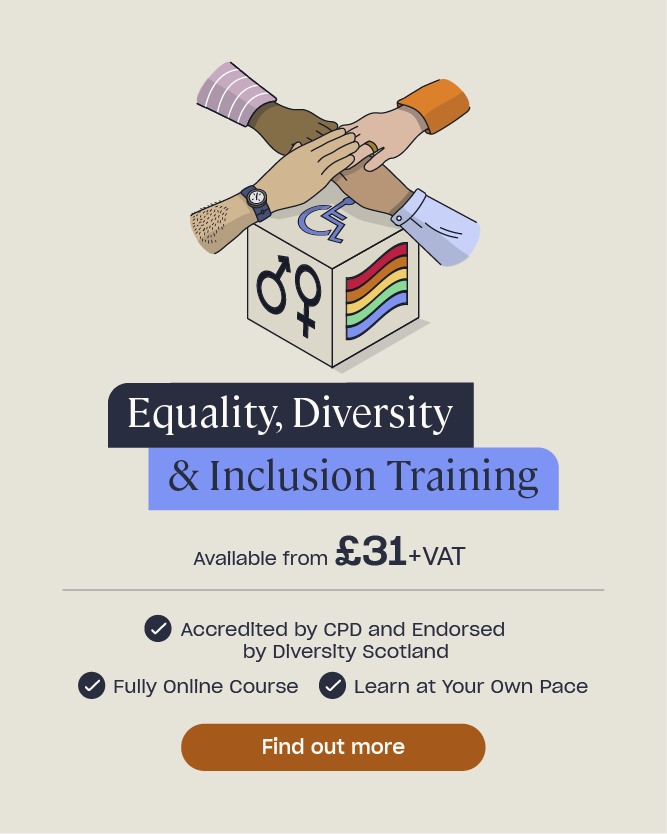How To Promote Equality & Diversity in Health & Social Care
Equality and diversity are essential components of health and social care. Good equality and diversity practices make sure that the services provided to people are fair and accessible to everyone.
They ensure that people are treated as equals, that people get the dignity and respect they deserve and that their differences are celebrated. Equality and diversity shouldn’t be seen as bonus benefits to your health or social care setting but more as integral constituents.
What is Equality and Diversity?
Equality means ensuring everyone in your setting has equal opportunities, regardless of their abilities, their background or their lifestyle.
Diversity means appreciating the differences between people and treating people’s values, beliefs, cultures and lifestyles with respect.
Need a Certificate, Fast?
We can help you gain a CPD accredited certificate with our range of online Safeguarding Adults Training. Popular courses, such as Dementia Awareness Training and Information Governance Training, could help you gain a better understanding of your responsibilities in healthcare.

In a health and social care environment, it’s important that equality and diversity are at the heart of what you do. Your patients and service users are individual people. You should always strive to ensure that their diverse needs are met and ensure that they have equal access to the services you provide. This is particularly important for adults in need who, because of a disability, illness or their age, are unable to take adequate care of themselves and keep themselves from harm.
Promoting equality and diversity in the workplace is primarily concerned with preventing discrimination – whether this is active or passive. Sometimes your setting may be discriminating against a patient accidentally, particularly if the adult is vulnerable because of their health, age or disability, so having an awareness of the potential barriers and how to remove them is essential.
What the Law Says About Equality and Diversity 
There are four key laws relating to equality and diversity which you should be familiar with if you work in a health or social care setting. These are:
- The Equality Act 2010 – this legislation provides protection against discrimination for people who possess one or more of the nine specific protected characteristics. These are age, disability, marriage and civil partnership, pregnancy and maternity, race, religion and belief, sex, gender reassignment and sexual orientation.
- The Human Rights Act 1998 – this legislation outlines the basic human rights and principles of equality. The ‘FREDA’ acronym helps you to remember what is covered by the Act: Fairness, Respect, Equality, Dignity and Autonomy.
- The Mental Capacity Act 2005 – notably the Deprivation of Liberty Safeguards (DoLS) which aim to help people who lack the capacity to maintain their independence, dignity and the right to freedom. The DoLS aid vulnerable individuals to maintain their right to dignity and equality.
- The Care Act 2014 – this legislation provides six key principles which should underpin all work with vulnerable adults. This includes ensuring that adults receive support that’s personal to them, chosen by them and has their consent.
Equality for Adults in Need 
Adults in need, also known as vulnerable adults, are people who are unable to take adequate care of themselves or protect themselves from harm as a result of disability, age or illness. If you work in a care setting then it’s likely that you work with adults in need on a regular basis and its imperative that equality and diversity practices are upheld.
The nine protected characteristics covered by the Equality Act 2010 apply to all vulnerable adults, although some of the characteristics have more of a direct link which you need to be aware of. Understanding these protected characteristics, and how you can prevent discrimination against them, is essential.
Religion and belief
This characteristic refers to a person who follows any religion (including atheism) or who holds any philosophical belief. Depending on their religion or belief, the care you provide to the patient will vary, as certain religions disallow certain healthcare practices. You cannot simply use the same care approach for all religions as you’ll be at risk of indirect discrimination. People of all religions and beliefs are entitled to equal care.
This Multi-Faith Resource for Healthcare Staff from NHS Education for Scotland provides useful information about a range of different faith groups to help health and social care workers understand what individual requirements may be needed.
Disability
This characteristic refers to a person with a physical or mental impairment that has a substantial adverse impact on their day-to-day life. In order to promote equality for disabled people, you should consider whether any changes to your method of care are required. For example, are all areas of your setting accessible? Does information need to be provided in alternative formats, such as audio or Braille? Do people need personal care plans? People of all disabilities are entitled to equal care.
Particular attention should be paid to adults who lack the capacity to make decisions for themselves. The Deprivation of Liberty Safeguards protect people who lack capacity by enabling them to have as much control as possible over the decisions that affect them. All health and social care workers must comply with the guidance contained within the DoLS legislation.

Age
This characteristic refers to a person of a particular age or age group. A person’s age will affect their care needs, although be careful not to make assumptions. For example, never assume that an older adult has a poor memory or poor hearing, and never assume that a younger adult is too immature to make a decision. People of all ages are entitled to equal care.
Race
This characteristic refers to a person’s colour, nationality, and ethnic or national origins. As a health or social care worker, promoting equality in regards to race means being aware of (and responsive to) people’s cultural needs and sensitivities and adapting your methods as required. People of all races are entitled to equal care.
In the 2014/15 adult inpatient survey by NHS England, there was a mixed bag of results when it came to ethnicity. People who identified as White Irish and White and Black Caribbean tended to have more positive experiences in hospital than White British people, yet people from Indian, Pakistani, Bangladeshi and Arab backgrounds tended to have less positive experiences. Providing equal care for everyone should ensure that these imbalances are addressed.
Tips for Promoting Equality and Diversity 
In order to promote equality and diversity in your health or social care setting, everyone on your team needs to be fully understanding of the relevant legislation, principles and practices. Without the basic knowledge of equality and diversity, it can be difficult to get people to promote and support it.
Firstly, does your setting have an equality and diversity policy? If so, make sure you’ve read it and then circulate it around your team. Similarly, do your best to ensure that everyone is appropriately trained in Equality and Diversity, the Deprivation of Liberty Safeguards and SOVA.
Next, encourage staff members to think about what matters to each person in your setting. What are each person’s values and goals? What does each individual need to attain their values and goals? If you and your fellow workers keep these questions in mind then the care you provide will always be in the individual’s best interests and you’ll always be keeping equality and diversity matters at the forefront.

The following questions, from NHS Scotland, will also help you to assess how well diversity is managed in your setting. Take a moment to consider how you would answer them:
- Who accesses your services?
- How do you ensure that equal access to services and treatment is provides for all?
- What are the specific issues that people with any of the protected characteristics as defined in the Equality Act 2010 may have?
- What do you know about their needs and experiences?
- How are or would these issues and needs be addressed in your work setting?
- What examples of diversity can you identify in the patient/client group you are currently working with?
- How do these factors influence the care you provide?
- What examples of diversity can you identify amongst your colleagues?
- How does this diversity add to the care provided?
- What impact does this diversity have on the workplace culture and care provision?
Further Resources
- Safeguarding Adults Quiz
- Equality and Diversity Training
- 9 Ways To Promote Dignity In Your Care Home
- Equality & Diversity Quiz
- Defining the Different Types of Discrimination in Health and Social Care
- How to Help Others Promote Diversity, Equality and Inclusion
- What are Gender Health Inequalities?
- What are Inequalities in Health and Social Care?











